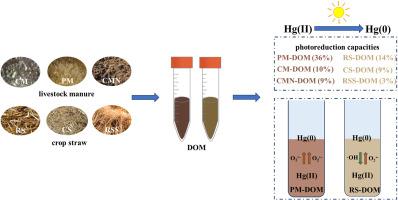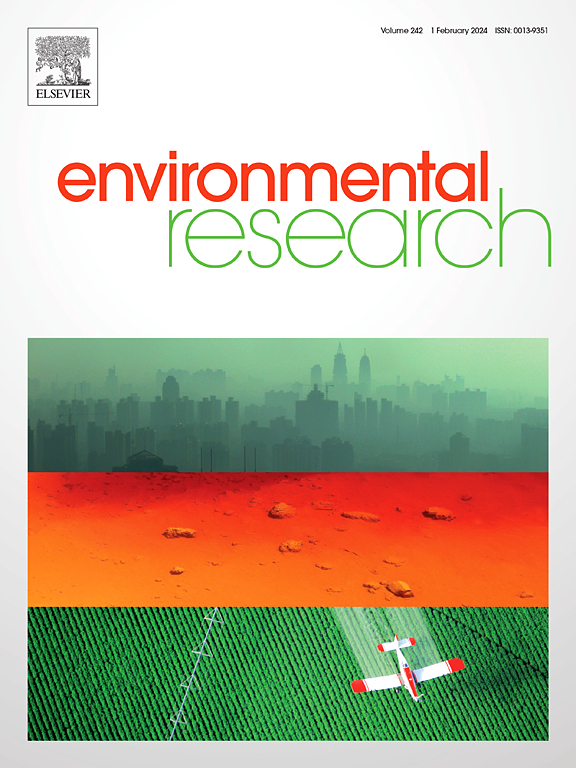Mercury reduction by agricultural organic waste-derived dissolved organic matter: Kinetic analysis and the role of light-induced free radicals
IF 7.7
2区 环境科学与生态学
Q1 ENVIRONMENTAL SCIENCES
引用次数: 0
Abstract
Agricultural organic wastes can leach dissolved organic matter (DOM) into surrounding water bodies, establishing them as significant sources of aquatic DOM. Given the importance of DOM in biogeochemical cycling of mercury (Hg), this DOM may mediate divalent Hg (Hg(II)) reduction, a process that remains poorly understood. This study investigated Hg(II) reduction using DOM derived from six representative agricultural wastes, categorized into livestock manure (chicken, pig, cow) and crop straw (rice, corn, rapeseed), with systematic considerations of the kinetics of reduction processes and the involvement of key free radicals. Results revealed that photoreduction was the primary pathway for Hg(II) reduction, with pig manure DOM exhibiting the highest efficiency at 36%. Key DOM quality parameters, such as protein-like components, have been identified as critical determinants of Hg(II) photoreduction capacity. Furthermore, free radicals induced by DOM could either enhance or inhibit Hg(II) reduction capacities. Specifically, in livestock manure, the superoxide anion (O2•-)·was identified as the primary radical promoting Hg(II) photoreduction of pig manure DOM. In crop straw, hydroxyl radicals (·OH) were found to inhibit Hg(II) photoreduction, whereas O2•- promoted the Hg(II) photoreduction of rice straw DOM. These findings provide valuable insights into the role of agricultural organic wastes in biogeochemical cycling of Hg within aquatic ecosystems.

农业有机废物产生的溶解有机物对汞的还原作用:动力学分析和光诱导自由基的作用。
农业有机废弃物会将溶解有机物(DOM)渗入周围水体,使其成为水生 DOM 的重要来源。鉴于 DOM 在汞(Hg)的生物地球化学循环中的重要性,这种 DOM 可能会进一步介导二价汞(Hg(II))的还原,而这一过程目前还鲜为人知。本研究利用六种具有代表性的农业废弃物(分为畜禽粪便(鸡粪、猪粪、牛粪)和农作物秸秆(水稻、玉米、油菜籽))产生的 DOM 研究了汞(II)的还原过程,系统地考虑了还原过程的动力学和关键自由基的参与。结果表明,光还原是还原 Hg(II)的主要途径,其中猪粪 DOM 的还原效率最高,达到 36%。关键的 DOM 质量参数,如蛋白质类成分,已被确定为决定汞(II)光还原能力的关键因素。此外,DOM 诱导的自由基可以增强或抑制汞(II)还原能力。具体来说,在牲畜粪便中,超氧阴离子(O2--)被认为是促进猪粪 DOM 光还原 Hg(II)的主要自由基。在农作物秸秆中,羟自由基(-OH)被发现抑制了汞(II)的光还原,而 O2--则促进了水稻秸秆 DOM 的汞(II)光还原。这些发现为了解农业有机废物在水生生态系统中汞的生物地球化学循环中的作用提供了宝贵的见解。
本文章由计算机程序翻译,如有差异,请以英文原文为准。
求助全文
约1分钟内获得全文
求助全文
来源期刊

Environmental Research
环境科学-公共卫生、环境卫生与职业卫生
CiteScore
12.60
自引率
8.40%
发文量
2480
审稿时长
4.7 months
期刊介绍:
The Environmental Research journal presents a broad range of interdisciplinary research, focused on addressing worldwide environmental concerns and featuring innovative findings. Our publication strives to explore relevant anthropogenic issues across various environmental sectors, showcasing practical applications in real-life settings.
 求助内容:
求助内容: 应助结果提醒方式:
应助结果提醒方式:


